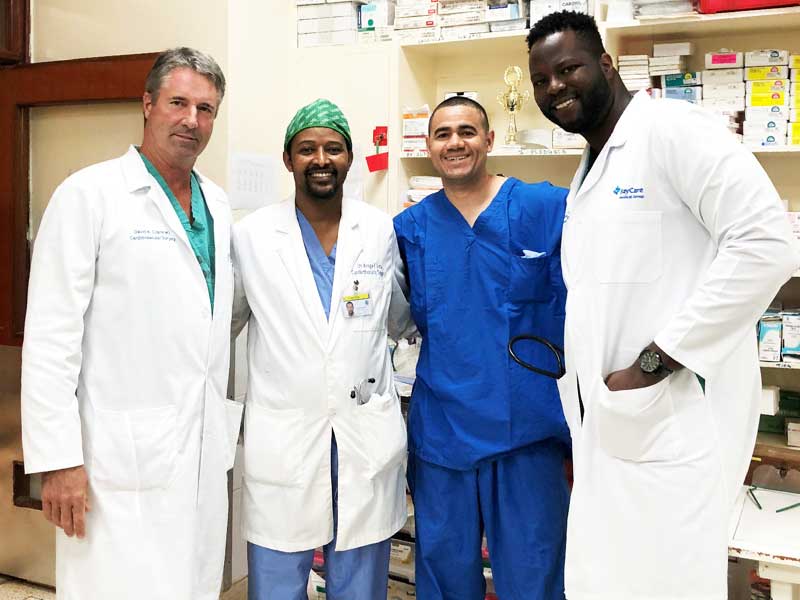by MARY TOOTHMAN
A group of local medical professionals traveled to Kenya earlier this year to provide instruction and medical care, and it seems likely there will be a return trip at some point in the future.
Dr. David Evans, a BayCare Medical Group cardiovascular surgeon, physician assistant Dave Reid, and Winter Haven Hospital Cardiovascular Operating Room Nurse James Fuentes traveled to Tenwek Mission Hospital in Kenya, Africa to perform heart surgeries on patients suffering from rheumatic heart disease.
The disease is caused by regular bouts with acute rheumatic fever, which can cause the heart valves to stretch or scar. When detected early, it can be treated with medicine. Because of a lack of access to regular health care, however, it can take days for patients to travel to the hospital, which is located in the hills of western Kenya. The disease can go untreated for a long time.
Dr. Evans, who was one of the first physicians recruited by Winter Haven Hospital for its Bostick Heart Center, says this was his second trip there. “I was there 33 years ago, and back then, it was just a small clinic with one other doctor. And now, it is the largest mission hospital in Africa, as far as I know.”
Connections and communications among the group of medical professionals eventually led to the mission trip plan. “Our anesthesiologist for the trip, Dr. Vincent Palmire — with Ocala Heart Center — had been going for the last several years and has been important in building the heart program at this hospital,” Evans says.
“One day, we got to talking, and we realized we knew the same hospital. After that, we worked out a trip where we would take our team and show them how we do open heart surgeries,” Evans says. “The four of us went and did two weeks of open heart surgeries and teaching them setup, pre-op-, intra-op, the procedure, post-op, patient care — all aspects.”
The results were gratifying. “We were able to get them from three-to four-hour procedures to doing the operation in one hour. The patients did well, and we had no complications while we were there on really sick patients. And they were excited to be able to maintain that,” he says.
He hopes to return. “I will probably go back one day. It was fun to see how the hospital has grown and changed. Now they have a nursing school, a residency program, a fellowship program, they have satellite clinics. It’s a hundred times larger than it was.
“When I was there the first time, we worked with a diesel generator that generated electricity for a couple hours a day and a couple rooms in the hospital, and now they have a whole hydroelectric plant powered by a waterfall near the hospital. That’s been instrumental in helping it grow.”
And there were also benefits for the Florida group. “It was also great to be able to take our teamwork from here to there, and it showed how we can replicate that teamwork anywhere. And it strengthened our team dynamic.”
Dave Reid, a physician’s assistant in cardiothoracic and vascular surgery, says the trip was a great opportunity. “I have done mission trips before, including to the Dominican Republic in 2011. When Dr. Evans offered me an opportunity to go with him on this mission trip, I said, ‘Why not?’ Not everyone gets the chance to go to Africa.
“We went for two weeks this past June, and we had a slot of one week for us to come in to do surgeries. The total travel time was 22 hours, and the drive from the airport to the hospital was about four hours. It’s up in the mountains, at about 6,000 feet in the air.”
And they were welcomed. “We had patients lined up for us, and some had been waiting for up to a month for surgery,” he says.
In Kenya, patients face more difficulties. “Here in the U.S., you can get treatment in a month or less,” Reid says. “There, people are waiting so long for treatment that when they finally get to surgery, the heart is enlarged and distorted and you can tell they’ve been living with this disease for a long time.
“After the surgery, you can see the heart begin to go back to its normal size, but that will take a few months. The biggest complaint is of shortness of breath and fatigue. It limits their physical activity. The average age of patients was 20, so that means that they are resilient and can recover faster.”
Overall, Reid says, it was satisfying to visit Kenya and help others. “It was nice to see another part of the world, to see how other people are living, see what other people are dealing with,” he says. “It gives you an appreciation for what you currently have. It’s always good to give back if you’re in a position to do that.”
James Fuentes, charge nurse in cardiovascular operating room, agrees. “I had never done anything like that before,” he says. “I always wanted to do something like this, and I am glad I went and was glad to help other people. I know that if I needed help, I would want people to help me if they could.
“I felt like we had a big impact with the staff. They were usually working from 8:30 in the morning and leaving at 11 p.m. We were starting at 10:30 a.m. and we would be done at 5 p.m. to 5:30 p.m.
“When the staff saw that, they were upbeat, and excited to be able to do things quicker so they could do more cases. I think that made a big difference. I would definitely do this again.”

